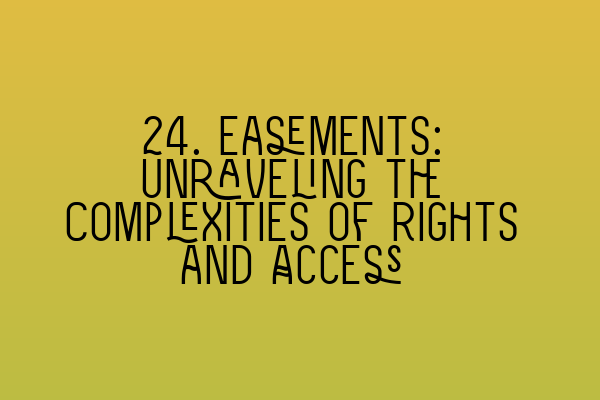Easements play a crucial role in property law, serving as the foundation for granting rights and access to individuals or entities over another person’s land. Understanding the complexities of easements is vital for property lawyers to provide accurate advice to their clients and effectively navigate property transactions and disputes.
In this blog post, we will unravel the intricacies of easements, shedding light on their definition, types, creation, and termination. So, let’s dive in and explore the fascinating world of easements!
What are Easements?
Simply put, an easement is a legal right that allows a person or entity to use or access someone else’s land for a specific purpose. Easements create a non-possessory interest in the land, giving the holder the right to use a portion of the property without actually owning it.
Examples of common easements include rights of way, where a person is granted the right to pass through another’s land to access their property. Other types of easements might allow for the installation of utilities, such as water pipes or electrical cables, on someone else’s land.
Types of Easements
Easements can be categorized into various types based on their nature and purpose. Let’s take a closer look at some of the common types:
Appurtenant Easements
An appurtenant easement is attached to a specific property and benefits its owner. It exists between two neighboring properties, commonly known as the dominant estate (the property benefiting from the easement) and the servient estate (the property burdened by the easement). Appurtenant easements transfer with the land, meaning they are binding on subsequent owners.
Easements in Gross
Unlike appurtenant easements, easements in gross are not tied to a specific property but to an individual or entity. They do not benefit any particular property and are usually granted for commercial purposes. Easements in gross are personal rights that do not transfer with the land, making them non-binding on subsequent owners.
Prescriptive Easements
Prescriptive easements are established through continuous and uninterrupted use of another person’s land without permission. To acquire a prescriptive easement, the claimant must demonstrate open, notorious, and adverse use for a specific period, which varies depending on the jurisdiction. These easements can arise when someone has openly used a path or road across another’s land for a certain number of years.
Creation of Easements
Easements can be created in several ways. The most common methods include:
Express Grant
Easements can be expressly granted, typically through a written document, such as a deed or contract. The grantor of the easement must have the legal authority to create the easement, and the document should clearly identify the parties involved, the purpose of the easement, its location, and any restrictions or conditions.
Implied Grant or Reservation
Implied easements arise when there is a clear implication of intent to create an easement, even though it is not explicitly stated in a written document. Implied easements are generally based on the principle of necessity or the historic use of the land.
Prescription
As mentioned earlier, prescriptive easements can arise when there has been continuous and adverse use of another’s land for a specific period of time. A court may grant a prescriptive easement if all the requirements are satisfied and the claimant can prove the necessary elements.
Termination of Easements
Easements can be terminated in several ways:
Expiration of Time
If an easement has a specified duration, it will terminate automatically once that time period ends. For example, an easement granted for 20 years will cease to exist after two decades.
Merger
If the dominant and servient estates come under the same ownership, the easement can be extinguished through merger. When one person acquires both properties, there is no need for an easement since they effectively have access to the land.
Abandonment
An easement may be terminated if the dominant estate owner voluntarily relinquishes their right to use the easement. Abandonment requires clear and unequivocal actions demonstrating an intent to surrender the easement.
Release or Surrender
An easement can be terminated by the mutual agreement of both parties involved. The dominant estate owner can release their right to use the easement, absolving the servient estate owner of any obligation to provide access or rights.
Conclusion
Easements are a complex yet essential aspect of property law, providing individuals and entities with invaluable rights and access to land. By understanding the various types of easements, their creation processes, and potential termination methods, property lawyers can effectively advise their clients and ensure the smooth navigation of property transactions and disputes.
If you’re preparing for your SQE exams and need assistance with property law or other subjects, we offer SQE 1 Practice Exam Questions and SQE 1 Practice Mocks FLK1 FLK2 to help you prepare effectively. Additionally, our SQE 2 Preparation Courses and SQE 1 Preparation Courses can provide comprehensive study materials and guidance for all your exam needs. Stay informed about SRA SQE Exam Dates to plan your preparation accordingly.
Contact SQE Property Law & Land Law today for expert advice and assistance with all your property law matters!
